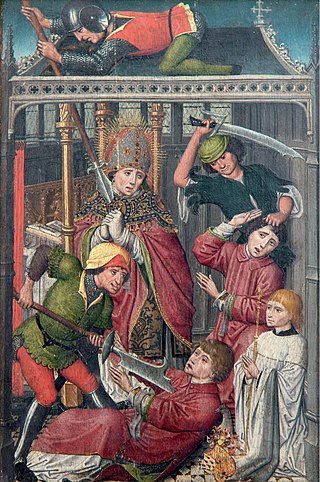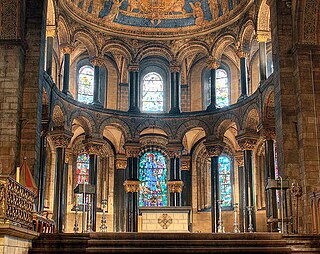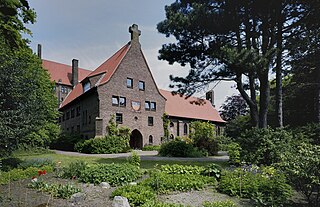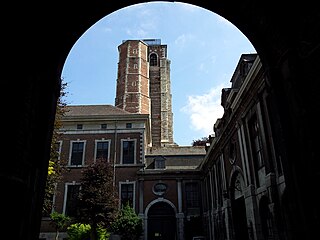
Maaseik is a city and municipality in the Belgian province of Limburg. Both in size and in population, it is the 8th largest municipality in Limburg. The town is the seat of the administrative arrondissement of Maaseik (kieskanton). Internationally, Maaseik is known as the assumed birthplace of the famous Flemish painters Jan and Hubert van Eyck.

Lambert of Maastricht, commonly referred to as Saint Lambert, was the bishop of Maastricht-Liège (Tongeren) from about 670 until his death. Lambert denounced Pepin's liaison with his mistress Alpaida, the mother of Charles Martel. The bishop was murdered during the political turmoil that developed when various families fought for influence as the Merovingian dynasty gave way to the Carolingians. He is considered a martyr for his defence of marriage. His feast day is September 17.

The County of Loon was a county in the Holy Roman Empire, which corresponded approximately with the modern Belgian province of Limburg. It was named after the original seat of its count, Loon, which is today called Borgloon. During the middle ages the counts moved their court to a more central position in Kuringen, which today forms part of Hasselt, capital of the province.

Susteren Abbey is a former Benedictine abbey at Susteren near Roermond, in the Dutch province of Limburg, founded in the 8th century. The former abbey church is now St. Amelberga's Basilica.

Mosan art is a regional style of art from the valley of the Meuse in present-day Belgium, the Netherlands, and Germany. Although in a broader sense the term applies to art from this region from all periods, it generally refers to Romanesque art, with Mosan Romanesque architecture, stone carving, metalwork, enamelling and manuscript illumination reaching a high level of development during the 11th, 12th and 13th centuries.

Charles-Nicolas-Alexandre d'Oultremont was Prince-Bishop of Liège from 20 April 1763 to his death in 1771. He was the eighth child of Jean-François-Paul-Emile, Count of Oultremont and of the Holy Roman Empire, and Marie-Isabelle of Bavaria, Countess of Warfusée and Druynen and Baroness of Schagen. He was born, lived and died in the castle of Warfusée.

The Canonesses Regular of the Holy Sepulchre (CRSS), or Sepulchrine Canonesses, are a Catholic female religious order first documented in 1300. They were originally the female branch of the ancient religious order of that name, the Canons Regular of the Holy Sepulchre. The canonesses follow the Rule of St. Augustine.
Mother Lettice Mary Tredway, C.R.L.,, courtesy title Lady Tredway, was an English canoness regular and abbess who founded a monastery for the English members of her Order in 17th-century Europe.

Soleilmont Abbey is an abbey of Trappistine nuns situated in the forest and commune of Fleurus, at Gilly near Charleroi, Belgium, founded, according to tradition, in the 11th century, which became Cistercian in 1237. The nuns were expelled as a consequence of the French Revolution in 1796, but soon re-established themselves in 1802. The community became Bernardine in 1837, and Trappist in 1919.

The Collegiate Church of St. Gertrude is a Roman Catholic collegiate church in Nivelles, Walloon Brabant, Belgium, which was built in the 11th century. It is dedicated to Saint Gertude, the patron saint of cats.

Egmond Abbey or St. Adalbert's Abbey is a Benedictine monastery of the Congregation of the Annunciation, situated in Egmond-Binnen, in the municipality of Bergen, in the Dutch province of North Holland. Founded in 920-925, and destroyed during the Reformation, it was re-founded in 1935 as the present Sint-Adelbertabdij, in the Diocese of Haarlem.

Herkenrode Abbey was a Catholic monastery of Cistercian nuns located in Kuringen, part of the municipality of Hasselt, which lies in the province of Limburg, Belgium.

Thorn Abbey or the Imperial Abbey of Thorn was an imperial abbey of the Holy Roman Empire in what is now the Netherlands. It was founded in the 10th century and remained independent until 1794, when it was occupied by French troops. The self-ruling abbey enjoyed imperial immediacy and belonged to the Lower Rhenish-Westphalian Circle.

Louis I was the Count of Loon, now in modern Belgium, and Burgrave of Mainz, in Germany. He inherited these offices from his father. He also established the County of Rieneck apparently based upon the Burgrave's lands.
The Wachtendonck Psalms are a collection of Latin psalms, with a translation in an eastern variety of Old Dutch. It contains a number of Old High German elements, because it was probably based on a Middle Franconian original. Very little remains of them. The psalms were named after a manuscript which has not come down to us, but out of which scholars believe the surviving fragments must have been copied. This manuscript was once owned by Liège Canon Arnold Wachtendonck. He was supervisor over Munsterbilzen Abbey, where he found the manuscript.

Sint-Truiden Abbey or St Trudo's Abbey is a former Benedictine monastery in Sint-Truiden in the province of Limburg, Belgium. The abbey was founded in the 7th century and was one of the oldest and most powerful in the Low Countries. The town of Sint-Truiden grew up around it. The great Romanesque abbey church, dedicated to Saint Remaclus and Saint Quintin, was demolished in 1798, four years after the suppression of the abbey.

Male Castle, Bruges. A community of the Canonesses Regular of the Holy Sepulchre. It originated in Bruges in the 11th century, and between 1954 and 2013 was settled in Male Castle in Male, Sint-Kruis, Bruges, West Flanders, Belgium.
Arnold I, Count of Loon (Looz) from about 1079, son of Emmo, Count of Loon, and Suanhildis, daughter of Dirk III, Count of Holland, and his wife Othelandis.
Count Gerard of Loon, was son and successor of Louis I, Count of Loon, and Agnes of Metz. He was count of Loon and of Rieneck. Because of a widespread misunderstanding concerning a document from 1101, some generations earlier, he is sometimes wrongly referred to as the second Gerard in this dynasty, "Gerard II".
The pagus or gau of Hasbania was a large early medieval territory in what is now eastern Belgium. It is now approximated by the modern French- and Dutch-speaking region called Hesbaye in French, or Haspengouw in Dutch — both being terms derived from the medieval one. Unlike many smaller pagi of the period, Hasbania apparently never corresponded to a single county. It already contained several in the 9th century. It is therefore described as a "Groẞgau", like the Pagus of Brabant, by modern German historians such as Ulrich Nonn.
















